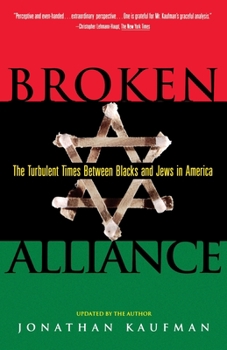Broken Alliance
Select Format
Select Condition 
Book Overview
Examines the history of black-Jewish relations in America, tracing the change from unification during the Civil Rights Movement and the growth of the Democratic Party to the mutual antagonism that surfaced during the 1984 election, and searches for the reason behind the rift. Jonathan Kaufman paints a vivid, moving portrait of the relationship between blacks and Jews in recent decades--from the strong partnership forged during the civil...
Format:Paperback
Language:English
ISBN:0684800969
ISBN13:9780684800967
Release Date:January 1995
Publisher:Scribner Book Company
Length:352 Pages
Weight:0.75 lbs.
Dimensions:0.8" x 5.7" x 8.7"
Customer Reviews
5 ratings
An interesting anecdotal look at the Black-Jewish alliance
Published by Thriftbooks.com User , 19 years ago
This book takes a good look at some social problems in America. It was written in 1988, but I have the updated edition from 1995. Blacks and Jews are minorities that cooperated during the civil rights struggles of the early 1960s. And there is still some cooperation on that issue, as various states continue to discriminate against minority voters. We see some of the cooperation and also some of the problems as this book as the experiences of six different people are examined in detail. Paul Parks, a Black who joined the civil rights movement in the 1960s, in chosen as an example of one who valued a Black-Jewish alliance. In April 1945, he was one of the soldiers who liberated the concentration camp at Dachau. But in 1967, he noted that there were complaints by some Blacks about Jewish landlords in the ghettos. Parks wanted to distinguish between the slumlords and those Whites who were actively helping the Blacks, given that without White support, Black causes would be hurt. But we see how many of the more politically involved Blacks thought of the Jews not as another minority but as part of the White majority. Next, we see Jack Greenberg and Esther Brown, who filed a landmark suit against segregated schools (Brown versus the Board of Education). These were Jews who saw the issue "not as a Negro cause but as a human cause." Still, there were problems when some Blacks decided to boycott a class that Greenberg taught at Harvard on "Race and the Law" to protest the fact that the instructor was not Black. After that, there is the story of Rhody McCoy, a Black who became the head of the Ocean Hills-Brownsville school district in New York City. Right away, there was a problem with a teacher strike. McCoy kept the schools open by hiring sustitute teachers, but this soured relations with the strikers. The issue became bigger, bitter, and painful, and certainly reduced cooperation among Blacks and Jews in the city. The story Kaufman tells next is of Roz Ebstein and her family. Hers was just one of many Jewish families in Chicago that supported the civil rights movement in the 1960s. But we discover the effects of blockbusting, as her neighborhood, rather than becoming integrated, simply became almost exclusively Black. Eventually, she and her family felt forced to move to a new neighborhood, a few miles away, in order to be in a better school district and to avoid harrassment from Blacks. There is an excellent section about Martin Peretz, who became the editor of The New Republic in 1974. Right away, we see one effect of Black-Jewish cooperation, namely that some Jews who learned more about Black culture and history decided they might as well learn about Jewish culture and history as well. Peretz, a liberal, couldn't stand Begin, a conservative Israeli Prime Minister. But Peretz made a point of supporting Israel's right to exist in the New Republic. Peretz, a stong supporter of civil rights, raised hundreds of thousands of do
Very honest personal stories
Published by Thriftbooks.com User , 19 years ago
I highly recommend this book - particularly the section on "the last Jewish liberals" who tried to make integration, civil rights work for their family in a changing South Side Chicago neighborhood.It didn't work, they eventually fled the lowrer class, Black takeover and moved to the suburbs, only they stayed longer than the other Whites.The book works well because the author writes very personal stories that present the truth about what happened.
history of Jews-African Americans
Published by Thriftbooks.com User , 22 years ago
Both Jews and blacks have suffered greatly in various parts of the world. In the United States, there has been somewhat of alliance between the two groups. Brokedn Alliances deals with this alliance, like the NAACP having many Jewish lawyers and how Jews and Blacks came toghether for the civil rights movement. It also deals with how these groups have been losing contact due many factors like black anti-semitism and the importance of Israel to American Jews. Broken alliances is definetely something people should read if they want a better understanding of the history of race relations.
Penetrating perspective
Published by Thriftbooks.com User , 22 years ago
The Jews and African Americans share a history of suffering and bigotry unequaled in recent times. History suggests that they should be the closest of partners in dealing with these issues. However to read the news you would think that they were historical enemies. This has not always been true. The Alliance between Jews and African Americans was a powerful force for change over most of this century. Jonathan tells the story of that Alliance and how it fell apart.As a journalist Jonathan tells this unique story from the perspective of important individuals on both sides. He traces them and their changing perspectives through these significant historical changes. It is this personal perspective that makes Jonathan's stories so compelling.
Broken Alliance
Published by Thriftbooks.com User , 23 years ago
This book was really interested and it really showed how the country was during the 60 anad all the racial problems that we still face today





